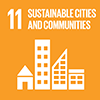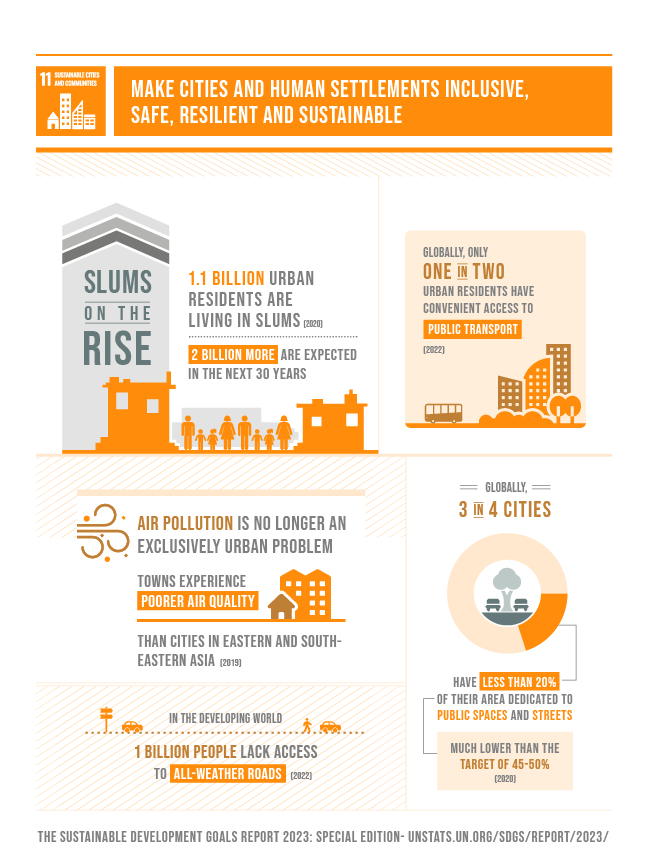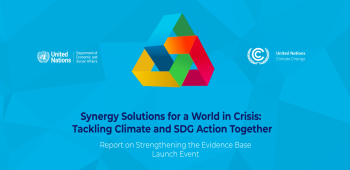
Disaster risk reduction

Sustainable transport

Sustainable cities and human settlements
Targets and Indicators

11.1
By 2030, ensure access for all to adequate, safe and affordable housing and basic services and upgrade slums
11.1.1
Proportion of urban population living in slums, informal settlements or inadequate housing

11.2
By 2030, provide access to safe, affordable, accessible and sustainable transport systems for all, improving road safety, notably by expanding public transport, with special attention to the needs of those in vulnerable situations, women, children, persons with disabilities and older persons
11.2.1
Proportion of population that has convenient access to public transport, by sex, age and persons with disabilities

11.3
By 2030, enhance inclusive and sustainable urbanization and capacity for participatory, integrated and sustainable human settlement planning and management in all countries
11.3.1
Ratio of land consumption rate to population growth rate
11.3.2
Proportion of cities with a direct participation structure of civil society in urban planning and management that operate regularly and democratically

11.4
Strengthen efforts to protect and safeguard the world’s cultural and natural heritage
11.4.1
Total per capita expenditure on the preservation, protection and conservation of all cultural and natural heritage, by source of funding (public, private), type of heritage (cultural, natural) and level of government (national, regional, and local/municipal)

11.5
By 2030, significantly reduce the number of deaths and the number of people affected and substantially decrease the direct economic losses relative to global gross domestic product caused by disasters, including water-related disasters, with a focus on protecting the poor and people in vulnerable situations
11.5.1
Number of deaths, missing persons and directly affected persons attributed to disasters per 100,000 population
11.5.2
Direct economic loss attributed to disasters in relation to global domestic product (GDP)
11.5.3
(a) Damage to critical infrastructure and (b) number of disruptions to basic services, attributed to disasters

11.6
By 2030, reduce the adverse per capita environmental impact of cities, including by paying special attention to air quality and municipal and other waste management
11.6.1
Proportion of municipal solid waste collected and managed in controlled facilities out of total municipal waste generated, by cities
11.6.2
Annual mean levels of fine particulate matter (e.g. PM2.5 and PM10) in cities (population weighted)

11.7
By 2030, provide universal access to safe, inclusive and accessible, green and public spaces, in particular for women and children, older persons and persons with disabilities
11.7.1
Average share of the built-up area of cities that is open space for public use for all, by sex, age and persons with disabilities
11.7.2
Proportion of persons victim of non-sexual or sexual harassment, by sex, age, disability status and place of occurrence, in the previous 12 months

11.a
Support positive economic, social and environmental links between urban, peri-urban and rural areas by strengthening national and regional development planning
11.a.1
Number of countries that have national urban policies or regional development plans that (a) respond to population dynamics; (b) ensure balanced territorial development; and (c) increase local fiscal space

11.b
By 2020, substantially increase the number of cities and human settlements adopting and implementing integrated policies and plans towards inclusion, resource efficiency, mitigation and adaptation to climate change, resilience to disasters, and develop and implement, in line with the Sendai Framework for Disaster Risk Reduction 2015-2030, holistic disaster risk management at all levels
11.b.1
Number of countries that adopt and implement national disaster risk reduction strategies in line with the Sendai Framework for Disaster Risk Reduction 2015–2030
11.b.2
Proportion of local governments that adopt and implement local disaster risk reduction strategies in line with national disaster risk reduction strategies

11.c
Support least developed countries, including through financial and technical assistance, in building sustainable and resilient buildings utilizing local materials
Progress and Info
Urbanization continues to accelerate, with more than half the global population now living in cities, projected to be nearly 70 per cent by 2050. However, cities face mounting challenges, including rising urban poverty, growing slum populations, inadequate public transport and threats to infrastructure from disasters. To advance Goal 11, cities need integrated strategies focused on affordable and inclusive housing, participatory urban planning, heritage preservation and stronger local governance, all supported by robust disaggregated data. Initiatives aimed at accelerating progress on Goal 11 include the Local2030 Coalition, which drives action on the Goals at the local level by bringing together United Nations entities, local governments and other partners.
Target 11.1 - Housing affordability is a pressing issue, affecting 1.6 billion to 3 billion people globally, encompassing challenges from homelessness to overcrowding and lack of basic services. Recent data from 124 countries reveal that the global average housing cost burden is 31 per cent, with sub-Saharan Africa at 43.5 per cent, compared with 21.4 per cent in Europe and Northern America.
Target 11.4 - In the period from 2019 to 2023, public funding for world heritage protection rose slightly but remained inadequate at $21.22 per capita (2017 purchasing power parity), with stark disparities between developing countries ($3.86 per capita) and developed countries ($83.30 per capita).
Target 11.5 - On average, 92,199 critical infrastructure units and facilities were destroyed or damaged by disasters annually from 2015 to 2023. Furthermore, disasters disrupted more than 1.6 million basic services, including educational and health services, each year.
Target 11.a - In 2023, the national urban policies of 68 countries addressed key development issues as follows: respond to population dynamics (59 countries, up from 54 in 2021); ensure balanced territorial development (55 countries, unchanged since 2021); and increase local fiscal space (33 countries, up from 26 in 2021). Progress in fiscal decentralization remains limited.
Target 11.b - In 2024, local-level disaster risk reduction governance improved, with 110 countries reporting local disaster risk reduction strategies and approximately 73 per cent of local governments having such strategies in place.






